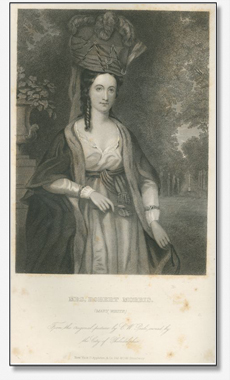
Rufus W. Griswold, The Republican Court, or, American Society in the Days of Washington. New and rev. ed. (New York, 1856), plate opposite 449. First ed., 1855.
MARY WHITE MORRIS (1749-1827) Mary White’s parents, Colonel Thomas and Esther White, were described by one historian as “people of the highest character” who were much respected and socially important members of the Philadelphia community.[1] Due to her parents’ status, Mary was well trained in high-society etiquette by the time of her marriage, at age twenty, to Robert Morris (1735-1806). Mary Morris was one of the favorite members of the Republican Court not only because of her husband’s importance, but also because of her dignified grace and her strength as a hostess. Rufus Griswold writes: “She was only twenty, but, by character and training, well adapted to take that social place which her husband’s wealth, political position, and native hospitality assigned to her.”[2] On March 2, 1769, she married Morris, a native of Great Britain who had gained significant material success by age thirty-five.[3] When George Washington ran into trouble financing his army, it was Morris who stepped in and provided funds; without his aid, Washington might never have been able to win the most decisive battles of the war. The two became great friends after this, and a strong and long-lasting friendship between their wives soon followed. Robert and Mary Morris even donated their Philadelphia mansion to the fledgling federal government for use as the President’s house while Philadelphia was the national capital. The Washingtons and the Morrises remained close friends even when Morris, having lost huge sums in land speculation, was in debtors’ prison for three years near the end of his life. George and Martha Washington invited Mary Morris to live with them during her husband’s imprisonment, but she declined the offer, preferring to stay with her family in her home in Philadelphia.[4] Before his financial downfall, Morris held political office at various levels, including the Continental Congress and the Pennsylvania State Senate; that prominence plus “his wealth, ability, and social position, made his home the centre of all the amenity and civility of the day, and it is as the hostess presiding over this establishment that we have some of the most pleasing pictures of his wife.”[5] Mary’s responsibility was to make that society’s upper crust would always feel welcome in her home, while at the same time caring for her seven children. In describing her grand presence as a hostess, Rufus Griswold writes:
Mary White Morris died twenty-one years after her husband, at age seventy-eight. Near the end of her life, she was so recognizable to the American community that even a glimpse of her at a window could cause an audience to applaud for so long that it “seemed as if [the ovation] would never cease.”[7] According to Charles Henry Hart, who presented a short biographical account of Mrs. Morris, there were three portraits painted in her likeness during her lifetime.[8] The portrait shown here is the only one that appeared in a work published in the antebellum period. Written by Annie Turner.
[2] Rufus W. Griswold, The Republican Court, or, American Society in the Days of Washington (New York: D. Appleton and Company, 1867), 216. [3] Oberholtzer, Robert Morris, 14. [4] Charles Henry Hart, “Mary White—Mrs. Robert Morris,” in Pennsylvania Magazine of History and Biography 2 (1878): 177. [5] Ibid., 165. [6] Griswold, The Republican Court, 313. [7] Ibid., 310. [8] According to Hart, these included the Charles Willson Peale portrait featured in The Republican Court, a miniature by John Trumbull, and an unfinished head painted by Gilbert Stuart. |

